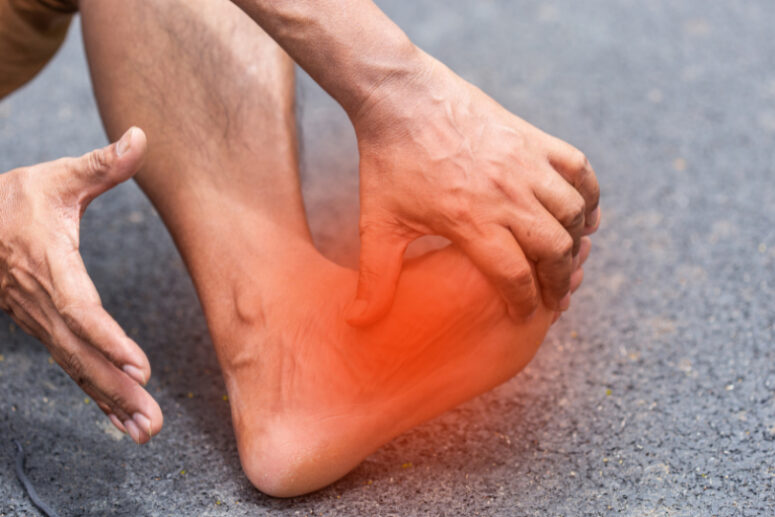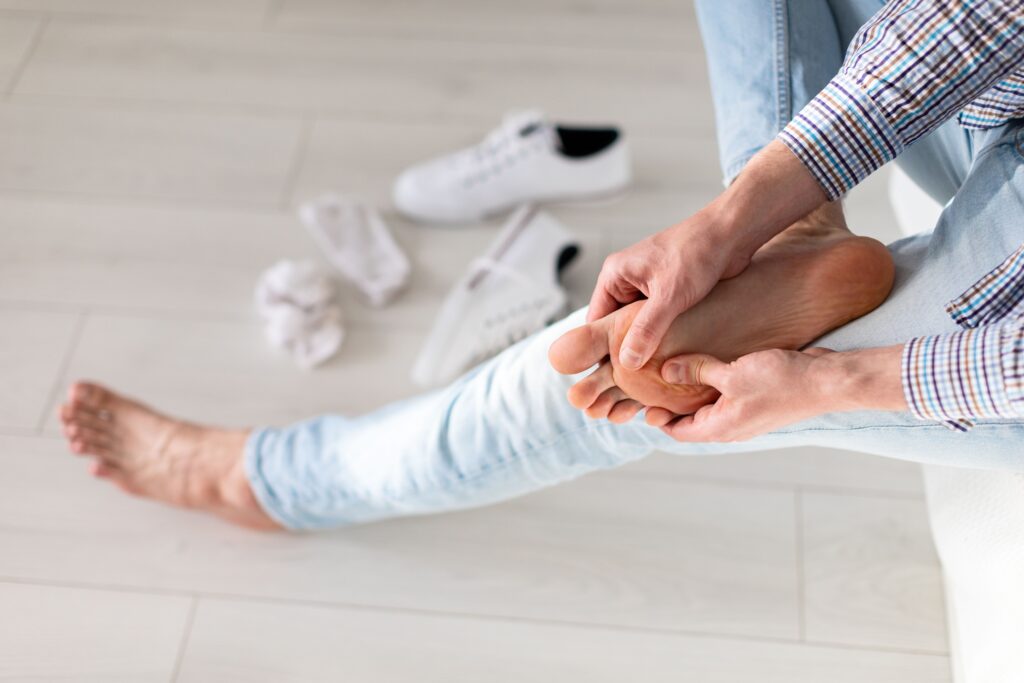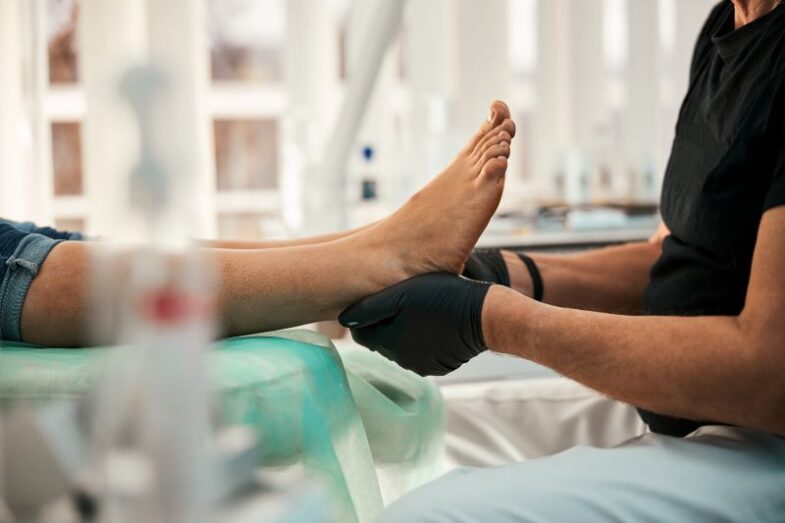Issues involving your feet can have serious effects on your daily life. Your feet allow you to move through the world, so it’s important that you take care of them. Even when you take care of your body, you still might find yourself with foot problems. Here are some of the most common foot-related problems and how to manage them.
 Foot Problems
Foot Problems
Plantar Fasciitis
The plantar fascia is the ligament on the bottom of your foot. It connects your heels to your toes while supporting the arch of your foot. It’s a very important ligament. Too much strain on this part of your body can cause inflammation known as plantar fasciitis.
Plantar fasciitis can cause pain in the heel and arch of your foot. Pain from plantar fasciitis is more likely to occur after exercise, in the morning, or after long periods of rest. Your Achilles tendon may also be tight if you are experiencing inflammation of the plantar fascia.
If you have plantar fasciitis, it can be managed in a variety of ways. In some cases, simple changes in lifestyle may be enough to reduce inflammation. Wearing better quality shoes, resting, and stretching can help treat plantar fasciitis. A cane or walking boot might be needed to relieve pressure in some instances. For severe cases, steroid injections and surgery are available. Surgery is typically reserved for patients who have tried other treatments but are still experiencing serious pain. Surgery involves separating the plantar fascia from the heel bone. It is a minimally invasive surgery.
Heel Spurs
Heel spurs are fairly common, affecting about 15% of people. A heel spur is a growth made from calcium deposits that form on the bottom of the heel bone. This growth causes pain when walking or running. Some people also feel pain after sitting for a long period of time. There are some similar symptoms between plantar fasciitis and heel spurs. Both cause pain on the bottom of the foot, including the heel. X-rays can distinguish between the two. Since heel spurs are made of calcium, they show up on x-rays, while plantar fasciitis does not.
Like plantar fasciitis, heel spurs can be managed by changing footwear. Shoes that support the arches of your feet reduce stress on your heel. Exercise and medications can also be used to treat heel spurs. When these options fail to work, surgery may be suggested by your doctor. Surgery removes the heel spur entirely, but it may cause other foot problems like hammertoes or flat-footedness.
Hammertoes
Hammertoes are caused by trauma or strain that forces the toes to curl unnaturally. Also called mallet toe, hammertoe describes a toe that is bent or curled even when it shouldn’t be. It is often painful to try to move the toe out of this position. It can be caused by uncomfortable footwear like high heels. Stubbing or breaking your toe can also cause a hammertoe. In some cases, an abnormal balance of muscles forces the toe to contract.
Hammertoe can be prevented by wearing shoes that are comfortable and fit correctly. Anything tight or pointed may increase your risk of developing a foot disease. Switching to better shoes might help correct hammertoes after they’ve already developed. Stretching your foot muscles is a popular treatment method to relax the toes. Again, in severe cases, surgery may be necessary to release the muscle causing the hammertoe.
Flat Feet
Flat feet might not sound like a serious condition, but they can cause a lot of pain for some people. People with flat feet don’t have a typical arch in their feet. Flat footedness is also called “pes planus”. Many people are born with flat feet. It can even be run in the family. For those born with flat feet, the condition may not cause any noticeable problems. People who develop flat feet over time are more likely to experience pain as a result.
Flat feet can be caused by injuries that affect tendons in your feet. Athletes are at a higher risk of developing flat feet as a result of a sports injury. Signs of flat feet can include pain, swelling, numbness, and calluses. Many people treat their flat feet by wearing shoes that support the arches of their feet. Exercise can also help treat flat feet. For very severe cases, surgery can treat pes planus. Surgery is often the last resort because it may involve serious changes like fusing bones together. Surgery can also be used to create an arch or repair damaged tendons.
 Bunions
Bunions
A bunion is a large bump that develops on the joint of the big toe. It is caused by the big toe being forced closer to the other toes. The bump itself is actually the bone pushing outwards while the toe points inward. Tight shoes can cause bunions by pushing the big toe in the direction of the smaller toes. Bunions can be identified by the large bump that usually forms at the base of the big toe. People with bunions may experience pain, stiff toes, and calluses. When left untreated, bunions can significantly worsen over time.
Changes in shoes can relieve bunion pain. Anti-inflammatory medication and certain injections can improve bunion symptoms. Bunion surgery may also be used to correct the issue.
Athlete’s Foot
While many foot conditions involve muscle and bone, some affect the skin of your foot. Athlete’s foot is caused by a fungus that thrives in warm, wet environments. People often contract athlete’s foot in locker rooms, gyms, and showers, hence its name. Athlete’s foot develops as a skin disease on the feet. It causes dry, itchy skin and blisters. It’s treated with over-the-counter products for persistent cases. Most of the time, keeping your feet dry and clean can treat athlete’s foot.
Plantar Wart
Like athlete’s foot, plantar warts affect the skin of the foot. Plantar warts form on the bottom of the foot as a result of an infection. Sometimes warts will go away on their own. They can also be treated with medication or even microwave radiation.
Sesamoiditis
Sesamoiditis refers to inflammation around the bones of your big toe. It’s most common in people who bend their big toe a lot. This includes athletes like those who participate in ballet. Letting your feet rest, pain relievers, and ice are common treatment options.
Diabetic Neuropathy
Diabetes can cause nerve damage, resulting in diabetic neuropathy. Diabetic neuropathy causes numbness or tingling in the feet. It can be treated by managing blood sugar levels or using medications.
Callus on the Side of Big Toe
Calluses can form anywhere on your feet, including on the side of your big toe. Calluses form as a result of repeated friction. They are thick, hard patches of skin. Some calluses are normal, but too many can indicate a problem. Calluses on your big toe could indicate a problem with your gait. You could be putting too much pressure on your big toe. Calluses can be treated by removing the hardened skin or softening it with medication.
 Foot Pain Diagram
Foot Pain Diagram
The location of your foot pain can tell you a lot about its cause. If you feel pain in your heel, it could indicate a heel spur. Pain in the sole of the foot might mean you have plantar fasciitis. Using a foot pain diagram might help you narrow down potential causes, but it’s no substitute for a professional opinion. When you aren’t sure about the cause of your foot pain, trust the Foot and Ankle Specialists of Illinois.

